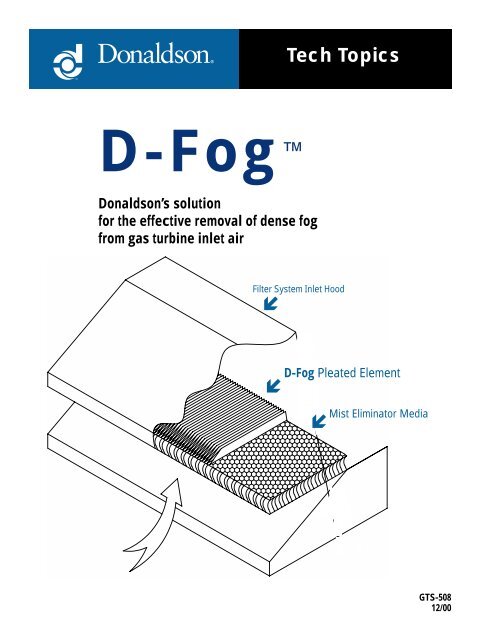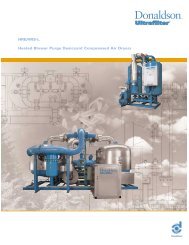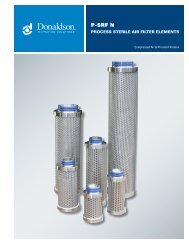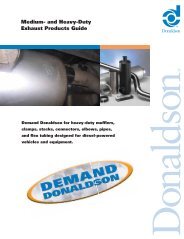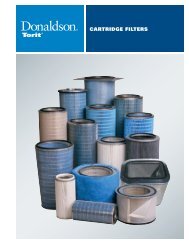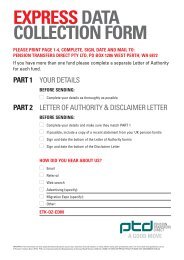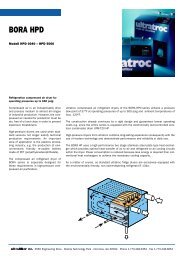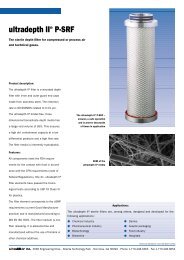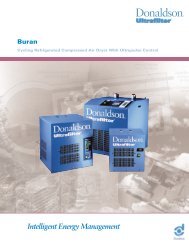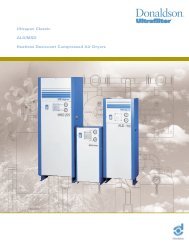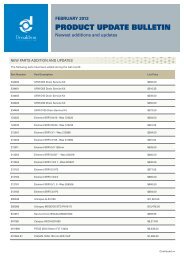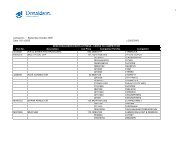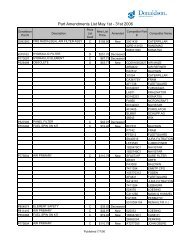Donaldson D-Fog - odms.net.au
Donaldson D-Fog - odms.net.au
Donaldson D-Fog - odms.net.au
You also want an ePaper? Increase the reach of your titles
YUMPU automatically turns print PDFs into web optimized ePapers that Google loves.
Tech Topics<br />
D-<strong>Fog</strong> <br />
<strong>Donaldson</strong>’s solution<br />
for the effective removal of dense fog<br />
from gas turbine inlet air<br />
Filter System Inlet Hood<br />
!<br />
!<br />
D-<strong>Fog</strong> Pleated Element<br />
!<br />
Mist Eliminator Media<br />
GTS-508<br />
12/00
<strong>Donaldson</strong> D-<strong>Fog</strong><br />
fog removal solution<br />
<strong>Donaldson</strong> D-<strong>Fog</strong> :<br />
Air Inlet Filtration Accessory and Operating Plan<br />
for Environments with Frequent Occurrences of Dense <strong>Fog</strong><br />
by Ben Nelson, PE, Product Development Engineer<br />
Gas Turbine Systems, <strong>Donaldson</strong> Company, Inc.<br />
bknelson@mail.donaldson.com<br />
Document Contents<br />
I. Introduction<br />
II. Background<br />
A. Physical Characteristics of <strong>Fog</strong><br />
B. Influence of Humidity and Moisture on Filtration Media<br />
C. Influence of Humidity and Moisture on Contaminant<br />
D. When to Pulse-Clean<br />
III. Product Description & Operating Plans<br />
A. D-<strong>Fog</strong> Product Description<br />
B. D-<strong>Fog</strong> Operating Principle<br />
C. Applications<br />
1. Contaminants that swell when exposed to humidity<br />
2. Contaminants that swell when exposed to water droplets<br />
3. Contaminants that do not swell from either humidity<br />
or water droplets<br />
4. Contaminants that deliquesce with humidity (salts)<br />
D. Installation<br />
E. Maintenance<br />
IV. Conclusions<br />
! Copyright 2000, <strong>Donaldson</strong> Company, Inc.<br />
All right reserved globally.<br />
page 2
<strong>Donaldson</strong> D-<strong>Fog</strong><br />
fog removal solution<br />
<strong>Donaldson</strong> D-<strong>Fog</strong> <br />
I. Introduction<br />
Gas turbine inlet air filtration systems have historically had difficulty<br />
maintaining a low operating restriction during periods of heavy fog. Typically, a<br />
filter system exposed to fog will experience a rise in restriction that exceeds one<br />
or more of its alarm setpoints. The turbine then shuts down by the air filter<br />
alarm control signal; alternatively, operators experienced in managing the<br />
phenomena may reduce the power output as a means to maintain continued<br />
operation.<br />
Since the occurrences happen primarily when the air is saturated with visible fog,<br />
it has been assumed that this excess moisture wets the filter media and c<strong>au</strong>ses the<br />
fibers to swell. However, an extensive test program completed by <strong>Donaldson</strong><br />
Company, Inc. has identified the contaminant collected on the filter media —<br />
not the media itself — as the c<strong>au</strong>se of the excessive restriction. Many<br />
environmental contaminants captured on air filter media will expand or swell<br />
when exposed to water droplets or high humidity. The swelling of these<br />
contaminants reduces the free area available for the air to pass through.<br />
Additionally, the fog particles themselves block passages that are normally open<br />
for airflow. This reduced permeability, in turn, increases the restriction that an<br />
air filter imposes on a given airflow. The test results were consistent for<br />
<strong>Donaldson</strong> moisture resistant filter media.<br />
As a result of this research, <strong>Donaldson</strong> has developed the D-<strong>Fog</strong> coalescing filter<br />
to control the ingestion of fog, combined with a filter element maintenance<br />
program to limit the effects of those contaminants prone to swell in the presence<br />
of high humidity or water droplets. Successful incorporation of this program<br />
will ensure that the inlet air filtration system will be able to perform adequately<br />
during periods of heavy fog exposure.<br />
II. Background<br />
A. Physical Characteristics of <strong>Fog</strong><br />
The findings of the report, Microphysical Properties of <strong>Fog</strong> at Otis AFB*, were<br />
used as a basis for structuring the test program and establishing the engineering<br />
parameters for the D-<strong>Fog</strong> accessory filter system and operating plan. The report<br />
details an extensive analysis of droplet size and concentration with respect to<br />
elevation, wind direction (i.e. source of condensation nuclei), and lapsed time in<br />
the life cycle of a fog event.<br />
* Microphysical Properties of<br />
<strong>Fog</strong> at Otis AFB, Bruce<br />
Kunkel, 26 January 1982.<br />
In addition to this report, it has been assumed that the relative humidity<br />
coincident with fog approaches 100%. This assumes the fog is formed when the<br />
ambient temperature falls below the dewpoint temperature and the excess water<br />
vapor condenses on the condensation nuclei present in the surrounding air.<br />
page 3
<strong>Donaldson</strong> D-<strong>Fog</strong><br />
fog removal solution<br />
The following excerpts from the Microphysical Properties of <strong>Fog</strong> at Otis AFB<br />
report are relevant to the parameters used in the D-<strong>Fog</strong> program:<br />
“Describing a typical droplet spectrum for (advection) fogs is difficult since no<br />
two droplet spectra are alike. Droplet size spectra vary not only from one fog<br />
episode to another, but also during the life of a particular fog and with height<br />
above the ground.”<br />
“The common feature of…samples taken, is, without exception, the high<br />
concentration of particles below 2.5 "m: that is, apparently, the result of inactive<br />
or haze nuclei.”<br />
“…a typical or mean spectrum of the data collected. It is characterized by a<br />
primary mode between 0.5 and 2.0 "m, a secondary mode or plate<strong>au</strong> between 5<br />
and 10 "m, and a plate<strong>au</strong> between 15 and 30 "m.”<br />
“The distribution of liquid water....is bimodal with peaks at about 10 "m and 30<br />
"m.”<br />
Since <strong>Donaldson</strong>’s standard mist eliminator efficiency is very high on droplets 55<br />
"m and larger, the D-<strong>Fog</strong> accessory and operating plan is designed to address the<br />
effects of droplets smaller than 55 "m.<br />
B. Influence of Humidity and Moisture on Filtration Media<br />
All of <strong>Donaldson</strong>’s moisture resistant filter media used for gas turbine air inlet<br />
filtration are very resistant to both high humidity and water droplets. The<br />
synthetic media has a strong resistance to water by virtue of the fibers being<br />
non-absorbent. The Duratek media undergoes a resin treatment that enhances<br />
its resistance to water. The Spider-Web ® fine fiber treatment is also a material that<br />
does not absorb moisture.<br />
Laboratory tests on clean filter elements indicate only a negligible increase in<br />
restriction (0.1" to 0.2") by introducing high humidity to <strong>Donaldson</strong> elements,<br />
even after several hours of operation. A measureable, but tolerable, rise in<br />
restriction was achieved by feeding an artificially excessive concentration of fog --<br />
up to 2" after an extended operating time (7 hours.) This gain in restriction is<br />
due to particulate loading of the fog droplets. The restriction on the elements<br />
decreases promptly when the fog challenge is removed.<br />
C. Influence of Humidity and Moisture on Contaminant<br />
Contaminants have varying degrees of sensitivity with respect to moisture. As<br />
they are pieces of their bulk parent components, it is believed that their behavior<br />
with respect to humidity and moisture will be characteristic of their bulk parent<br />
forms, i.e. clay and cement dusts will bind when mixed with water, salts will<br />
deliquesce in the presence of humidity, etc. The exact behavior of contaminants<br />
becomes very complex to predict when they combine with materials of other<br />
families such as in the case of the dust cake on an air filter.<br />
page 4<br />
Many of these environmental contaminants will expand, or swell when exposed<br />
to moisture. When they are present in the dust cake on a filter element, the<br />
swelling of these contaminants reduces the free area available for air to pass
<strong>Donaldson</strong> D-<strong>Fog</strong><br />
fog removal solution<br />
through. This reduced permeability, in turn, increases the restriction that an air<br />
filter imposes on the turbine airflow.<br />
The introduction of fog presents a unique challenge in that very small water<br />
droplets (0.5 to 30 "m in size) are suspended in air that is typically at 100%<br />
relative humidity. This makes it very difficult to determine if a rise in restriction<br />
is c<strong>au</strong>sed by high humidity or by water droplets. The addition of fog to an<br />
established dust cake on a filter element can swell the contaminant from either<br />
its high humidity or its water droplet content.<br />
Successful turbine operation in locations with frequent occurrences of fog and<br />
moisture-sensitive contaminant will involve a two-part program consisting of a<br />
<strong>Donaldson</strong> D-<strong>Fog</strong> coalescing filter accessory combined with a main filter<br />
replacement schedule that limits the amount of contaminant present.<br />
D. When to Pulse-Clean<br />
A gas turbine air inlet filtration system is better able to manage a fog event when<br />
there is the least amount of contaminant on the filters.<br />
The performance of a <strong>Donaldson</strong> GDX pulse-clean air inlet filtration system can<br />
be optimized by daily pulse-cleaning the elements via manual operation of the<br />
pulse-clean system. The pulse-clean should be placed in manual mode (the "on"<br />
position on the control panel) for the length of time required to make one<br />
complete cycle through the elements. For sites that do not run 24 hours a day, it<br />
is preferable to do this while the turbine is off-line if a source of compressed air<br />
is available.<br />
At the onset of a fog event, the system should be manually pulsed continously<br />
until the restriction has returned to the conditions prior to the fog.<br />
Although pulse-cleaning is beneficial in maintaining a lower pressure drop<br />
during periods of high humidity, it may not be as effective on removing<br />
contaminant during these periods, depending on the nature of the contaminant.<br />
A daily pulse cleaning will facilitate more efficient removal of contaminant while<br />
it is in a dry state. The daily pulse-clean regimen is a proactive method of<br />
controlling contaminant build-up during a time when most contaminants will<br />
more readily shed themselves from the elements.<br />
III. Product Description and Operating Plan<br />
A. D-<strong>Fog</strong> Product Description<br />
The D-<strong>Fog</strong> filter accessory is a pleated coalescer element and retention frame<br />
that retrofits standard <strong>Donaldson</strong> gas turbine hood assemblies. The retention<br />
frame is a one-time modification installed into the hood assemblies.<br />
D-<strong>Fog</strong> is a pleated coalescer<br />
element that fits into<br />
<strong>Donaldson</strong> inlet hoods.<br />
page 5<br />
The D-<strong>Fog</strong> coalescer element is a flexible, expandable, polymer media pack that<br />
is packaged with the pleats compressed. Upon installation, the media pack<br />
expands inside the hood and is placed in a horizontal orientation on top of the<br />
mist eliminators. Element pleats are self-spacing by means of the pre-attached<br />
spacing ribbons. The unit is held in place by means of a clamping fixture at each
<strong>Donaldson</strong> D-<strong>Fog</strong><br />
fog removal solution<br />
side of the hood and a series of retention rods spaced across the width of the<br />
element. The coalescer element is serviceable by either replacement or cleaning.<br />
The cleaning can be done with the elements in place if the turbine is not operating.<br />
B. D-<strong>Fog</strong> Operating Principle<br />
During a fog or rain event, water is filtered from the inlet air via increasing stages<br />
of moisture removal efficiency. The first stage of separation occurs at the hoods<br />
themselves. The larger rain and coalesced water droplets cascade down the front<br />
of the hood panels and fall to the ground. Smaller water droplets entrained in the<br />
airstream strike the second stage mist eliminators and are removed by means of<br />
inertial separation. These droplets coalesce and fall to the hood panels, then run<br />
off to the ground.<br />
Ribbons on the backside<br />
of the D-<strong>Fog</strong> makes the<br />
pleats self-spacing.<br />
In the third stage, the finer fog droplets that have traversed the tortuous path<br />
through the mist eliminators impinge upon the D-<strong>Fog</strong> coalescing element. The<br />
impinged droplets grow in size by coalescing with other droplets. Once the<br />
coalesced droplets reach a size that is too large for them to remain in suspension,<br />
they fall back through the airstream and mix with the droplets captured by the<br />
mist eliminators.<br />
The air leaving the D-<strong>Fog</strong> element is free of visible fog.<br />
C. Applications<br />
Gas turbine sites that historically experience a restriction rise during fog events<br />
will behave differently depending on the contaminants to which they are exposed.<br />
Their behavior with the D-<strong>Fog</strong> accessory and the recommended operating plan<br />
can be characterized as follows:<br />
1. Contaminants that swell when exposed to humidity. This is the most difficult<br />
condition to remedy. Although the D-<strong>Fog</strong> coalescing filter will remove the fog<br />
droplets from the air, it will not remove the 100% relative humidity condition that<br />
is coincident with the fog. These events are often perceived as being c<strong>au</strong>sed by the<br />
fog bec<strong>au</strong>se of their coincidence in time, when, in reality, the restriction rise<br />
accrues from the 100% humidity condition alone. This type of site condition<br />
must be addressed by replacement of the main filter elements with new and clean<br />
elements at the beginning of the fog season. To compliment this maintenance<br />
schedule, the D-<strong>Fog</strong> coalescing filter provides the following benefits to ensure that<br />
turbine operation is not interrupted:<br />
page 6<br />
a. <strong>Fog</strong> droplets will be removed from the airflow to minimize their<br />
detrimental effects. The extent to which the contaminant swells will be<br />
limited to that c<strong>au</strong>sed by the humidity effects alone.<br />
b. The main filter elements will not be subjected to the additional<br />
particulate loading presented by the fog contaminant. Since fog is an<br />
aerosol, the entrained moisture droplets can add to the dust cake, filling<br />
in the voids previously traversed by the airstream. The D-<strong>Fog</strong> filter will<br />
remove visible droplets and their associated particulate loading<br />
effects.<br />
c. The D-<strong>Fog</strong> coalescing filter will serve as a prefilter to prevent a portion<br />
of the contaminant from reaching the main filter elements, extending the<br />
service life, and associated restriction rise, of the main filters.
<strong>Donaldson</strong> D-<strong>Fog</strong><br />
fog removal solution<br />
2. Contaminants that swell when exposed to water droplets. The D-<strong>Fog</strong><br />
coalescing filter accessory will remove virtually all of the water from the<br />
airstream that is in droplet form. This will minimize the exposure of liquid<br />
water droplets to any contaminant on the main filter elements. This type of site<br />
can follow a more conventional schedule for replacement of the main filter<br />
elements assuming the operational history shows that the contaminant is not<br />
affected by high humidity.<br />
3. Contaminants that do not swell from either humidity or water droplets. The<br />
D-<strong>Fog</strong> coalescing filter will prevent the main filter elements from being<br />
overwhelmed by the fog’s particulate loading effects if the operational history of<br />
the site deems this as a concern. The benefits of the D-<strong>Fog</strong> filter accessory will<br />
not be as pronounced for this application as they are for the other contaminant<br />
conditions.<br />
The D-<strong>Fog</strong> filter accessory may also be considered for its merits as a prefilter<br />
if there is a particular problem contaminant at the site.<br />
4. Contaminants that deliquesce with humidity, , typically salts. Usually found<br />
in off-shore or coastal applications. Although the D-<strong>Fog</strong> filter accessory will not<br />
prevent the main elements from being exposed to high humidity and the<br />
subsequent bleed-through of salts from deliquescence, it will limit the amount of<br />
liquid water droplets that reach the main filter elements during fog events.<br />
D. Installation<br />
The specification of a D-<strong>Fog</strong> filter accessory requires an engineering review of<br />
the existing air filter assembly by <strong>Donaldson</strong> Gas Turbine Systems Design<br />
Engineering. The review will determine quantities for each of the D-<strong>Fog</strong><br />
accessory components. After the design review, a retrofit kit can be detailed to<br />
meet the site requirements.<br />
The erection at the gas turbine site will involve the installation of a retention<br />
hardware package for the D-<strong>Fog</strong> coalescing filter accessory. Once these<br />
components are in place, the D-<strong>Fog</strong> filter elements can be installed immediately<br />
or scheduled for the beginning of the next fog season.<br />
E. Maintenance<br />
Since D-<strong>Fog</strong> is a fibrous coalescing element, it will capture contaminant and<br />
experience a restriction rise as it loads with dust. <strong>Donaldson</strong> recommends that<br />
the D-<strong>Fog</strong> elements be serviced when their restriction reaches 1" above the initial<br />
clean value.<br />
page 7<br />
The preferred method of cleaning is by using a portable pressure washer with the<br />
elements in place and the turbine off-line. Position the pressure spray to span<br />
one trough of the element pleats and move the wand from the near end of the<br />
hood to the far end of the hood. When the spray reaches the far end of the<br />
hood, it will deflect the pleats and direct any accumulated water out of the hood.<br />
Another method of cleaning is with compressed air from a nozzle. This also<br />
must be done with the turbine off. The success of this type of cleaning method<br />
will depend on the nature of the contaminant collected.
<strong>Donaldson</strong> D-<strong>Fog</strong><br />
fog removal solution<br />
The D-<strong>Fog</strong> element is<br />
compressed when shipped<br />
to save on freight &<br />
storage space.<br />
The full length of the<br />
D-<strong>Fog</strong> element spans the<br />
width of the inlet hood.<br />
Its construction makes it<br />
self-spacing.<br />
Alternatively, the D-<strong>Fog</strong> media packs can be<br />
removed from the filter housing, cleaned<br />
with water or air, and reinstalled. Bec<strong>au</strong>se of<br />
the additional labor required, it is likely that<br />
this method would only be used for a turbine<br />
that must remain on-line continuously. A<br />
spare set of D-<strong>Fog</strong> elements will ensure<br />
protection during the service period.<br />
IV. Conclusions<br />
Once fitted with the retention hardware, a<br />
<strong>Donaldson</strong> gas turbine air inlet filtration<br />
system can be fitted with D-<strong>Fog</strong> coalescing<br />
elements during the seasons that are known<br />
to be prevalent with fog. The D-<strong>Fog</strong><br />
coalescing accessory will eliminate the<br />
introduction of fine fog droplets onto the<br />
main filter elements. This, along with a<br />
disciplined pulse-cleaning schedule and<br />
seasonal replacement of the main filter<br />
elements as required, will ensure that the<br />
inlet air filter system will remain operational<br />
when challenged with fog.<br />
The D-<strong>Fog</strong> elements will capture a large<br />
portion of the contaminant that enters a filter<br />
system, thereby reducing the amount of<br />
contaminant that reaches the main filter<br />
elements. The loaded D-<strong>Fog</strong> elements can<br />
be replaced while the turbine is on-line, or<br />
washed in place while the turbine is off-line.<br />
The maintenance requirements for the D-<strong>Fog</strong><br />
operating plan are all measurable and<br />
predictable activities. The successful<br />
implementation of these will ensure that the<br />
turbine will remain operational during<br />
periods of dense fog.<br />
##<br />
Where to Find Us:<br />
website: www.donaldson.com<br />
email: filterinfo@mail.donaldson.com<br />
or gts-europe@mail.donaldson.com<br />
or gts-asiapacific@donaldson.com.sg<br />
<strong>Donaldson</strong> Company, Inc.<br />
Gas Turbine Systems<br />
P.O. Box 1299<br />
Minneapolis, Minnesota 55440 USA<br />
Phone 952-887-3543<br />
Fax 952-887-3843<br />
Parts/Elements 800-431-0555<br />
<strong>Donaldson</strong> Europe N.V.<br />
Research Park Zone 1<br />
Interleuvenlaan, 1<br />
B-3001 Leuven, Belgium<br />
Phone 32-16-38-3940<br />
Fax 32-16-38-3939<br />
<strong>Donaldson</strong> Filtration Asia Pacific Pte Ltd<br />
No. 9, Changi South Street 3, #07-01<br />
Singapore 486361<br />
Phone 65-6546-4400<br />
Fax 65-6546-4325<br />
<strong>Donaldson</strong> Far East Ltd.<br />
Unit A, B & C, 21/F CDW Bld.<br />
388 Castle Peak Road<br />
Tsuen Wan, N.T. Hong Kong<br />
Phone 852-2402-2830<br />
Fax 852-2493-2928<br />
<strong>Donaldson</strong> Shanghai<br />
Unit F2, 6/F<br />
Zhao Feng Universe Building<br />
1800 Zhong Shan West Road<br />
Shanghai 200233<br />
Phone 86-21-6440-1808<br />
Fax 86-21-6440-1639<br />
DI Filter Systems Pvt. Ltd.<br />
D-44, Gulmohar Park<br />
New Delhi 110-049 India<br />
Phone 91-124-633-7350/ 633-7351<br />
Fax 91-11-6569534<br />
Nippon <strong>Donaldson</strong> Ltd.<br />
13-2, 5-chome, Imadera<br />
Ome City, Tokyo 198 Japan<br />
Phone 81-428-31-6399<br />
Fax 81-428-31-7076<br />
<strong>Donaldson</strong> Australasia Pty. Ltd.<br />
Lucca Rd, Wyong, New South Wales<br />
Australia 2259<br />
Phone 61-02-4352-2022<br />
Fax 61-02-4351-2036<br />
GDX, Spider-Web, Duratek, and Pleatloc are tradenames of the<br />
<strong>Donaldson</strong> Company, Inc. <strong>Donaldson</strong> Company, Inc. reserves<br />
the right to change or discontinue any model or specification at<br />
any time and without notice. Copyright 2000.<br />
Printed in U.S.A. An Equal Opportunity Employer<br />
Digital Imagery © Copyright 2000 PhotoDisc, Inc.


